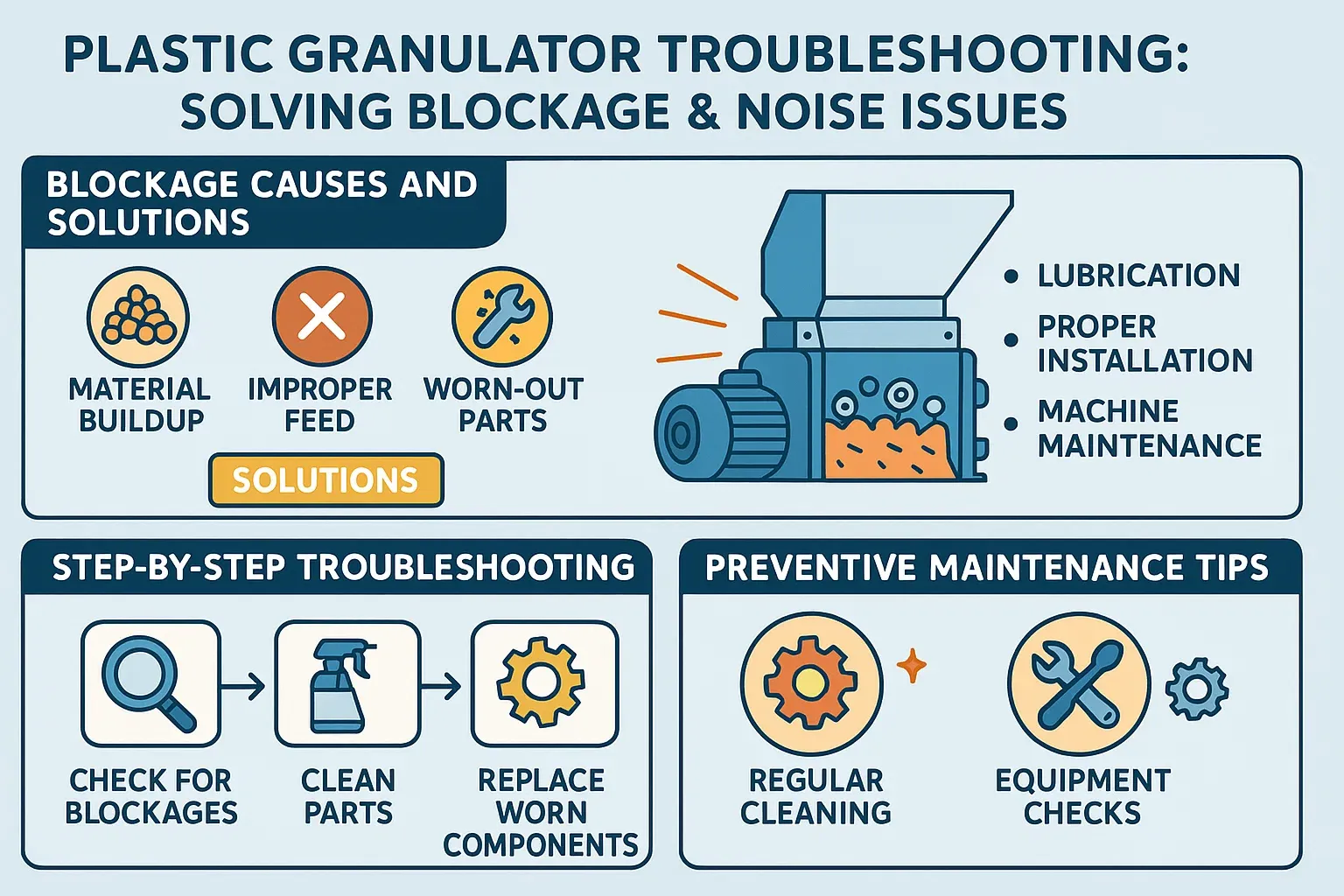Troubleshooting Your Plastic Granulator: Solving Common Blockage and Noise Issues
플라스틱 분쇄기 are the workhorses of the recycling and manufacturing industries, efficiently reducing plastic scrap, rejects, and purgings into reusable regrind. However, like any hard-working machine, they can encounter operational issues. Two of the most frequent headaches are blockages 그리고 excessive noise. These problems not only halt production and decrease efficiency but can also pose safety risks and indicate underlying maintenance needs.
For engineers, technical staff, and equipment purchasers aiming for smooth, efficient, and safe operations, understanding the root causes of these issues and knowing how to address them is crucial. Let’s dive into how to troubleshoot and solve these common plastic granulator challenges.
Understanding the Plastic Granulation Process
Before troubleshooting, let’s quickly recap how a typical granulator works. Plastic material is fed into a cutting chamber containing rotating and stationary knives (blades). These knives shear the plastic into smaller pieces, which then pass through a screen with specific hole sizes, determining the final particle size (regrind). The regrind is then collected, usually via a blower system or gravity feed.
Tackling Granulator Blockages: Causes and Solutions
A blocked granulator means downtime and lost productivity. Blockages typically occur in the cutting chamber or at the screen. Here’s a breakdown of common causes and how to fix them:
1. Overfeeding
Cause: Feeding material into the hopper faster than the granulator can process it. This overwhelms the cutting chamber.
Solution:
- Train operators on proper feed rates specific to the material and machine.
- Install a controlled feeding system (e.g., conveyor belt with adjustable speed, auger feeder) if manual feeding is inconsistent.
- Consider granulators with integrated feed rolls for bulky items.
2. Dull or Improperly Gapped Knives
Cause: Blunt knives don’t cut cleanly; they tear and chew the plastic. This requires more force, generates heat, and can cause material to melt or wrap around the rotor instead of passing through the screen. Incorrect knife gap settings also lead to inefficient cutting.
Solution:
- Implement a strict knife maintenance schedule (sharpening or replacement). The frequency depends on the material processed and operating hours.
- Ensure knives are correctly gapped according to the manufacturer’s specifications. Use feeler gauges for accuracy.
- Invest in high-quality, durable knives suitable for your specific application.
3. Incorrect Screen Size or Condition
Cause: Using a screen with holes too small for the desired throughput or material type can cause material buildup. A damaged or clogged screen (e.g., holes blocked by fines or melted plastic) restricts material flow.
Solution:
- Select the appropriate screen size based on the material type, required particle size, and the granulator’s capacity. Consult the manufacturer if unsure.
- Regularly inspect and clean the screen. Replace damaged or worn screens immediately.
- For sticky or heat-sensitive materials, consider specialized screen designs or processing techniques (e.g., air cooling).
4. Material Properties
Cause: Some plastics are inherently difficult to granulate. Soft, stretchy materials (like films or elastomers) can wrap around the rotor. Heat-sensitive plastics (like PVC or PET under certain conditions) can melt and smear due to friction heat in the cutting chamber. Contaminants (metal, stones, excessive dirt) can also cause jams and damage.
Solution:
- Pre-treatment: Ensure material is as clean and dry as possible. Remove contaminants before feeding. Consider pre-shredding for very large or bulky items.
- 온도 조절: For heat-sensitive materials, consider reducing the rotor speed (if possible), ensuring sharp knives, or using water-cooled or air-cooled granulator models.
- Specialized Rotors/Knives: Some granulators offer specific rotor designs (e.g., staggered knife, V-cut) better suited for film or other challenging materials.
5. Inadequate Evacuation System
Cause: If the regrind isn’t removed efficiently from below the screen (e.g., weak blower, clogged pipes, full collection bin), it can back up into the cutting chamber and screen area.
Solution:
- Ensure the blower system is adequately sized and functioning correctly.
- Regularly inspect and clean evacuation pipes and cyclones.
- Implement procedures to monitor and empty collection bins promptly.
Silencing the Roar: Addressing Excessive Granulator Noise
Granulators are inherently noisy, but excessive noise levels can indicate problems, violate safety regulations, and create an unpleasant working environment.
1. Dull or Unbalanced Knives
Cause: As mentioned, dull knives require more force, increasing vibration and noise. Unbalanced knives (due to uneven wear, incorrect installation, or damage) cause the rotor to vibrate significantly at high speeds.
Solution:
- Maintain sharp, correctly gapped knives.
- Ensure knives are installed correctly and torqued evenly. Replace knives in sets to maintain balance.
- Have the rotor assembly professionally balanced if vibration persists after knife maintenance.
2. Worn Bearings
Cause: Rotor bearings wear out over time, leading to increased friction, vibration, and a distinct grinding or whining noise.
Solution:
- Implement a bearing lubrication schedule as per manufacturer recommendations.
- Monitor bearings for signs of wear (noise, heat, vibration). Replace worn bearings promptly. Using high-quality bearings extends lifespan.
3. Loose Components or Improper Installation
Cause: Vibrations can loosen bolts on panels, guards, the frame, or motor mounts, leading to rattling and increased noise. If the granulator isn’t securely mounted on a level, solid foundation, vibrations can be amplified.
Solution:
- Regularly inspect and tighten all hardware.
- Ensure the granulator is installed on a level, stable surface. Use vibration-damping pads or mounts beneath the machine frame.
4. Material Type and Feed Rate
Cause: Hard, brittle plastics generally create more noise during granulation than softer ones. Dropping large, heavy parts into the hopper can also cause significant impact noise.
Solution:
- While material type is often fixed, controlled feeding can help reduce impact noise.
- Consider beside-the-press granulators with Auger feeds for sprue and runner recycling which can be quieter than hand or robot feeding large parts.
5. Machine Design and Enclosures
Cause: Basic granulator designs might lack noise-dampening features. Thin metal panels can easily resonate.
Solution:
- For Purchasers: When selecting a new granulator, consider models with built-in sound-dampening features (thicker steel, insulated panels, enclosed cutting chambers).
- For Existing Machines: Retrofit sound enclosures or sound-dampening blankets around the granulator. Ensure adequate ventilation if adding enclosures.
| Feature / Condition | Typical Noise Level | Potential Solution |
|---|---|---|
| Standard Granulator | 95-110+ dB(A) | Baseline |
| Dull Knives / Worn Bearings | Higher / Irregular | Maintenance (Sharpen/Replace, Lube) |
| Vibration (Loose Bolts) | Rattling / Higher | Tighten Hardware, Check Mounts |
| Sound-Dampened Model | 85-95 dB(A) | Specify During Purchase |
| Full Sound Enclosure | < 85 dB(A) | Purchase Option or Retrofit |
Preventative Maintenance: The Key to Smooth Operation
The most effective way to deal with blockages and noise is to prevent them. A robust preventative maintenance (PM) program is essential.
| Frequency | Task | Focus Area |
|---|---|---|
| 일일 | Check hopper for foreign objects | Input |
| 일일 | Listen for unusual noises (bearings, rotor) | Noise/Vibration |
| 일일 | Check regrind evacuation system (airflow) | 산출 |
| Weekly | Inspect knife sharpness and condition | 절단 효율성 |
| Weekly | Check screen for damage and cleanliness | Output Quality/Flow |
| Weekly | Inspect V-belts for tension and wear | 구동 시스템 |
| 월간 간행물 | Check and tighten all accessible bolts | Vibration/Noise/Safety |
| 월간 간행물 | Inspect bearing temperature/noise | Rotor Support |
| Quarterly/ As Needed | Lubricate bearings (per manufacturer) | Longevity |
| As Needed | Sharpen or replace knives | 절단 효율성 |
| As Needed | Check knife gap | 절단 효율성 |
올바른 분쇄기 선택 to Minimize Problems
For equipment purchasers, selecting the right granulator from the start can significantly reduce future headaches:
- Match Capacity: Choose a granulator appropriately sized for your throughput needs. Undersized machines are prone to overfeeding and blockages.
- Consider Material: Select a machine with cutting chamber geometry, knife type (e.g., V-cut, staggered), and screen options suitable for your specific plastic(s).
- 유지 관리 용이성: Look for designs that offer easy access to the cutting chamber, knives, and screen for cleaning and maintenance. Tool-less entry is a significant plus.
- 견고한 구조: Heavy-duty construction minimizes vibration and noise.
- Noise Reduction Options: Inquire about built-in sound insulation or optional sound enclosures, especially if locating the granulator near workstations.
- 안전 기능: Ensure the machine meets current safety standards (e.g., rotor lockouts, safety interlocks).
결론
Blockages and excessive noise in plastic granulators are common but often preventable issues. By understanding the root causes – from dull knives and improper feeding to worn bearings and poor maintenance – engineers and technical personnel can implement effective solutions. Regular preventative maintenance is paramount for ensuring consistent performance, maximizing uptime, maintaining regrind quality, and ensuring a safer working environment.
For purchasers, considering these potential issues during the selection process and investing in features designed for durability, ease of maintenance, and noise reduction will pay dividends in the long run through increased efficiency and reduced operational costs. A well-maintained, correctly operated granulator is a valuable asset; keeping it running smoothly is key to success in plastic processing and recycling.



